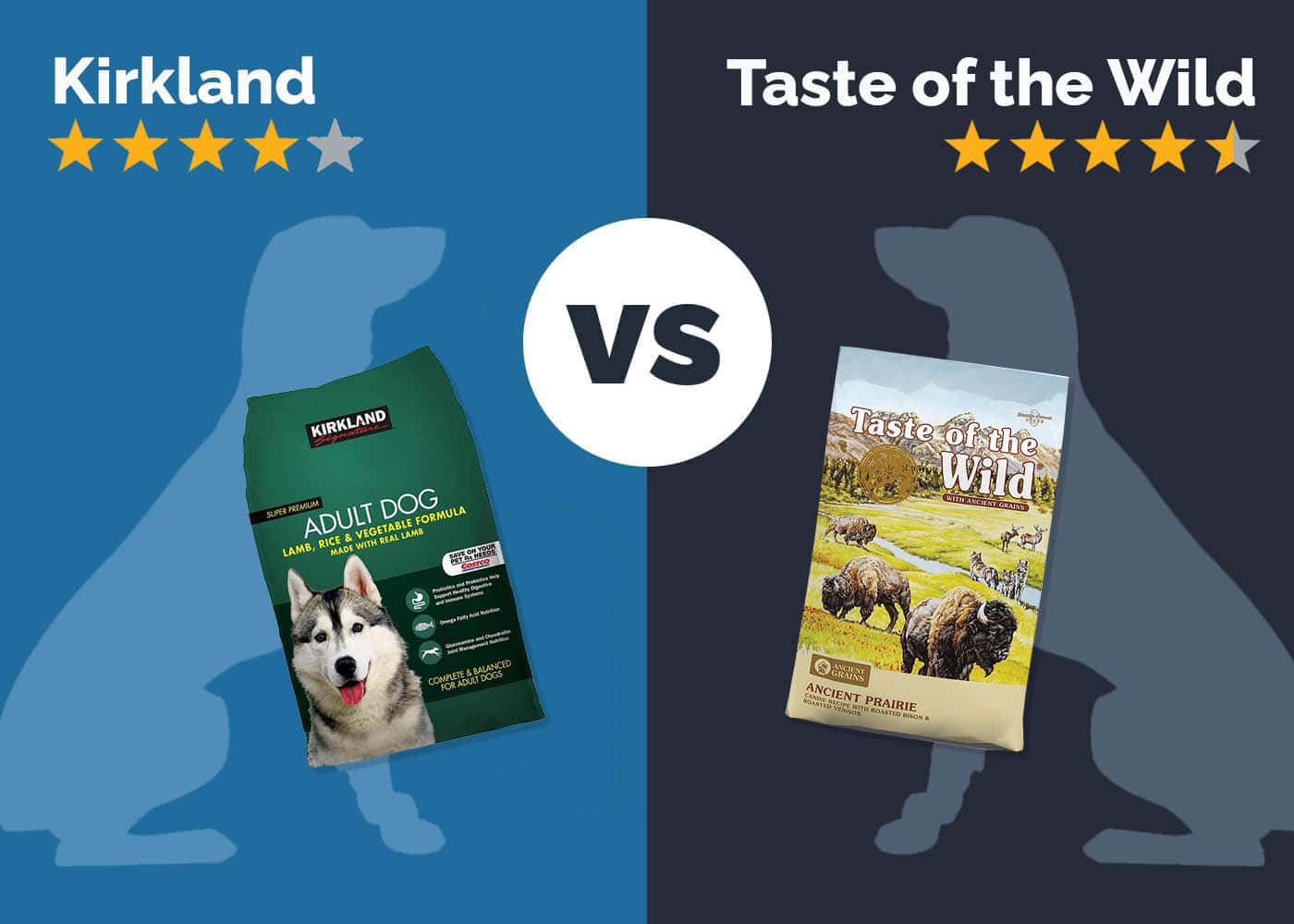Which Is the Best Meat for Your Dog? (18 Types of Meat Analyzed)

Updated on

If you spend enough time perusing the dog food aisle of your local pet store, you’ll notice that there are quite a few options when it comes to protein sources. It seems like you can find a dog food that features just about any type of meat known to man, but which one is the best? Is there one you should feed your dog and one you should avoid?
As it turns out, meat sources vary wildly in terms of nutritional value. Also, some are much more expensive than others, and some are simply hard to find.
In the guide below, we’ll walk you through the meats that are most commonly found in dog foods, so you can decide on the best one for your particular pup.
The Top 18 Types of Meat for Dogs
1. Chicken
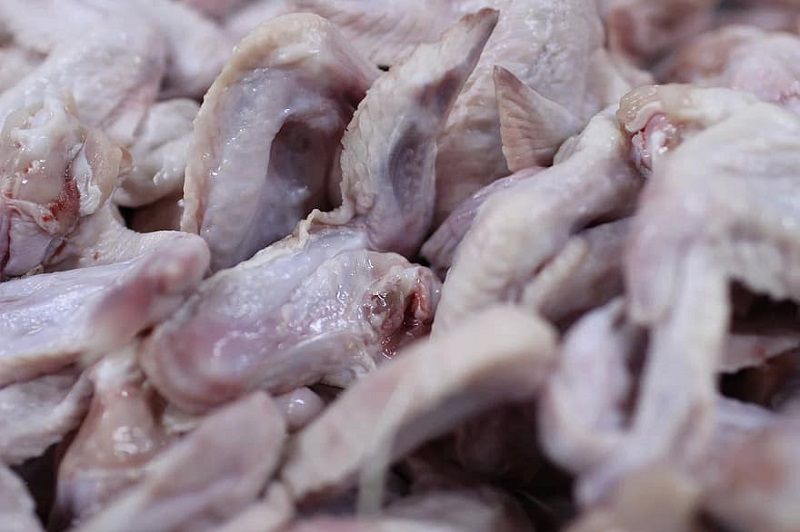
Chicken is likely the most common meat in dog food and for good reason: It’s high in protein, low in saturated fat, and eminently affordable. Also, just about every dog on the planet loves it, so you shouldn’t have any issues convincing your dog to wolf down a chicken-based food.
It’s important to note that “chicken” on a dog food label means that it’s made with lean meat; it’s also sometimes called “lean chicken,” “deboned chicken,” or something similar. This is not the same thing as chicken meal or chicken by-products.
To make chicken meal, manufacturers take all the parts of the bird—except feathers, blood, claws, and beaks—and render them together, a high-temperature process that removes all the moisture, making the meat easier to preserve. This sounds gross, but the organs are full of important nutrients that aren’t found in lean cuts of meat. However, the meals are not as high quality as the fresh lean cuts or organs.
Chicken by-products are the non-meat portions of the animal, including the internal organs. But if it is a by-product meal, that can also mean it comes from “4-D” meat. 4-D meat comes from dying, diseased, disabled, or dead animals. Since by-product meals are generic, you can’t tell their origin simply by looking at the label.
Ultimately, chicken is one of the best possible proteins that you can feed your dog, but you should do your research to make sure the poultry you’re giving your pup is up to your standards.
2. Beef

Beef is the second most popular meat in dog food. It’s full of protein and dogs love it, but it’s more expensive than chicken. In addition to a large amount of protein, beef has all the healthy fats that your dog needs. It does tend to be excessively fatty, though, so it may not be best for overweight dogs.
The quality of the beef can vary wildly depending on the cut used to make it, not to mention the quality of animals that it’s taken from. Most dog food labels won’t tell you which cut was used to make the kibble, with the exception of when the organ of origin is specified.
Beef is excellent for dogs and it’s easy to find in kibble. However, you should expect to pay a little bit extra for it, and don’t expect your dog to be able to live on this alone.
You should also consider that beef is not the most ecological option of protein to feed your dog, as the resource cost of production for this meat is the highest of all. Additionally, beef is a common allergen for dogs.
- Related Read: 10 Homemade Beef Dog Food Recipes (Vet-Approved)
3. Pork

Pork is a fairly common meat, making it easy to find a quality pork-based kibble. The price can vary depending on the overall quality of the food and what else is in it, but it should usually be more expensive than chicken.
You’ll find about as much protein in pork as you will in chicken or beef, but it generally contains way more fat.
Also, if you’re feeding pork to your dog as part of a homemade diet, make absolutely sure you cook it because it can contain parasites. Most dogs love the taste of pork, but it’s a bit more polarizing than beef or chicken.
There’s nothing wrong with feeding pork to your dog, per se. They should enjoy it, and it can give them all of the nutrition they need. However, you may be able to get more nutrition for less money by sticking with chicken or beef.
- Related Read: Can Dogs Eat Pork Rinds? Are Pork Rinds Safe for Dogs?
4. Salmon

Fish is a common meat in dog foods, and salmon is the typical type of fish used. It’s low in fat and high in protein; however, the biggest advantage salmon offers is that it’s packed with omega fatty acids. This is important for everything from brain health to developing a strong immune system. It also improves coat quality and skin health.
Salmon is also easy for most dogs to tolerate, making it a great choice for allergy-stricken pups. It should never be fed to a dog raw, though, as it can cause salmon poisoning disease, which can be fatal for dogs. Also, not all dogs care for the taste.
While salmon is one of the best possible foods that you can feed your dog, there is a downside: It’s expensive, at least relative to chicken and beef. Also, there are environmental concerns about salmon harvesting, and the meat quality can vary depending on where the fish was caught.
If you can afford to feed your dog salmon (and if they’ll eat it), you’ll be hard-pressed to find a better food for them.
5. Whitefish
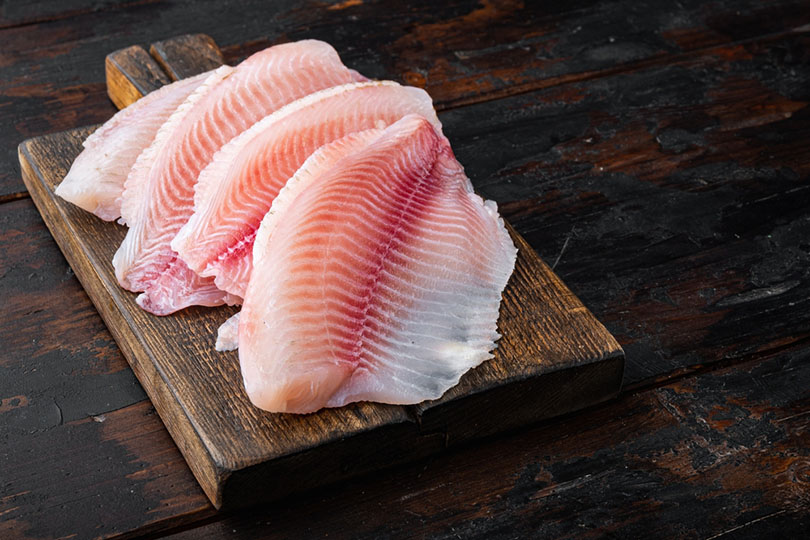
Most non-salmon fish-based food is made using whitefish. Whitefish isn’t a species of fish; rather, it’s a catch-all term used to distinguish these fish from oily fish, like salmon. Typically, the type of fish used in whitefish food is cod, whiting, or haddock. You won’t find many whitefish-based kibbles out there, so your selection will be limited right off the bat. What foods you do find will often have another protein source in addition to the whitefish (often salmon).
Like salmon, whitefish is high in protein and might be a good option for dogs with allergies to chicken or beef. However, it tends to be even more expensive.
If you’re feeding your dog a raw diet and want to incorporate whitefish, make sure to cook it first, and be absolutely certain that it’s been completely deboned. Small fish bones can wreak havoc on your dog’s digestive tract or get lodged in their throats.
Whitefish is an excellent protein source for dogs, but finding a suitable food can be a hassle. Ultimately, there’s little reason to choose whitefish over salmon if you want a fish-based food.
6. Tilapia
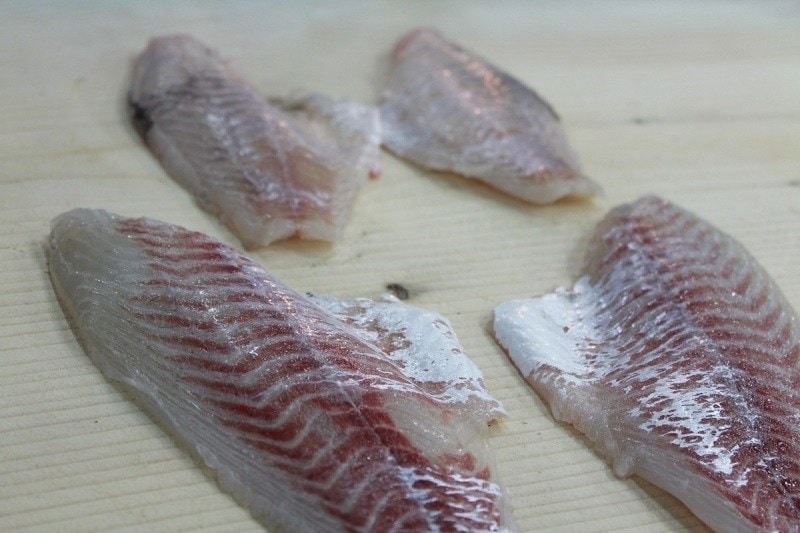
You’ll rarely, if ever, see tilapia used as part of a commercial kibble. However, it’s a popular protein in homemade diets, as it’s affordable and sold in just about every grocery store. It’s also easy to prepare, so making it the cornerstone of your dog’s raw diet shouldn’t be too much of a hassle. It’s something of a 50/50 shot whether your dog will eat it, though. Like with all fish, make sure to cook it before serving and be thorough about deboning it.
Tilapia is extraordinarily lean and packed with protein, making it one of the best bang-for-your-buck foods on the planet. It’s extremely low in calories, making it a good choice for dogs that need to lose a pound or two.
If you’re getting into the raw food trend, tilapia’s about as good of a meat as you can find to feed your dog. However, if you care at all about convenience, you’ll probably want to skip it in favor of something a little easier to find.
7. Turkey

Turkey is often seen as a substitute for chicken, as it has a remarkably similar nutritional profile. However, turkey may be easier for some dogs to tolerate, but it’s harder to find as a standalone protein source.
Most commercial dog foods that use turkey pair it with at least one other protein source; ironically, that protein is often chicken. If you look hard enough, however, you should be able to find one that only uses turkey.
Turkey should be fully cooked before being served, as it can carry Salmonella and other microbes. You should also be careful about feeding processed turkey to your dog, as it’s usually full of salt and other additives that aren’t healthy for mutts.
Turkey and chicken are somewhat interchangeable; however, turkey’s a tad bit more expensive and can be harder to find. As a result, we’d recommend sticking with chicken unless your dog has an allergy (or you have another compelling reason for avoiding that bird).
8. Duck

If your dog seems to turn up their nose at everything you offer them, duck may be the perfect way to tempt them. Most pups think that it’s absolutely delicious, so picky dogs should wolf it right down.
It’s also fairly expensive and difficult to find. You almost certainly won’t find a purely duck-based commercial kibble; almost all of them are paired with other protein sources (usually other birds, like chicken and turkey).
Due to its limitations, we’d recommend skipping duck unless you have an especially picky dog on your hands.
9. Lamb

Lamb is a relatively rare meat source, but it’s a gretprotein alternative, and most dogs love it.
At one point, it was rumored that lamb was hypoallergenic for dogs, but that’s not true. However, it’s still good for dogs with food allergies to other sources of proteins. It is considered a novel protein, as most pups have never been exposed to it.
Lamb is a good change-of-pace option compared to the more common meat sources, but you will likely have to pay more for it. Also, it may be harder to find a top-notch kibble with lamb as the primary ingredient.
10. Bison

Bison is a protein that’s becoming popular in high-end foods. It’s much like beef, except leaner, so most dogs will eat it without complaint. It has slightly more protein, which is why it often replaces beef in more expensive kibbles. You’ll find bison in many limited-ingredient foods, as it’s good for animals with food allergies.
As you might expect, given its relative rarity, bison is considerably more expensive than most other meats. The good news is that most bison-based foods are extremely high quality, so you shouldn’t expect to see a bunch of cheap fillers and additives in them. You may have to shop at specialty pet stores in order to find these foods, though.
If the price isn’t too daunting, bison is one of the best meats that you can feed your pup.
11. Goat
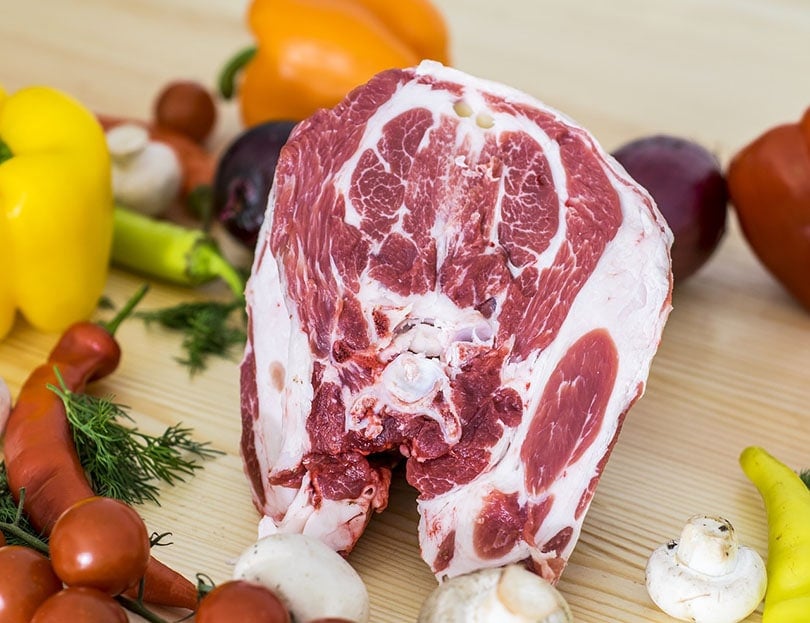
Goat-based commercial kibbles are extremely rare, but the meat is often used in raw food diets because it boasts a tremendous amount of protein and almost no fat. It may be difficult to find in grocery stores, but most butcher shops and ethnic food stores carry it, as it’s a popular meat in many parts of the world.
However, goat has an extremely strong flavor, and many dogs don’t care for it. If you can find it and your pup will eat it, though, it’s an amazing protein source.
Check out our list of best goat dog foods! 5 Best Goat Dog Foods – Reviews & Top Picks
12. Ostrich
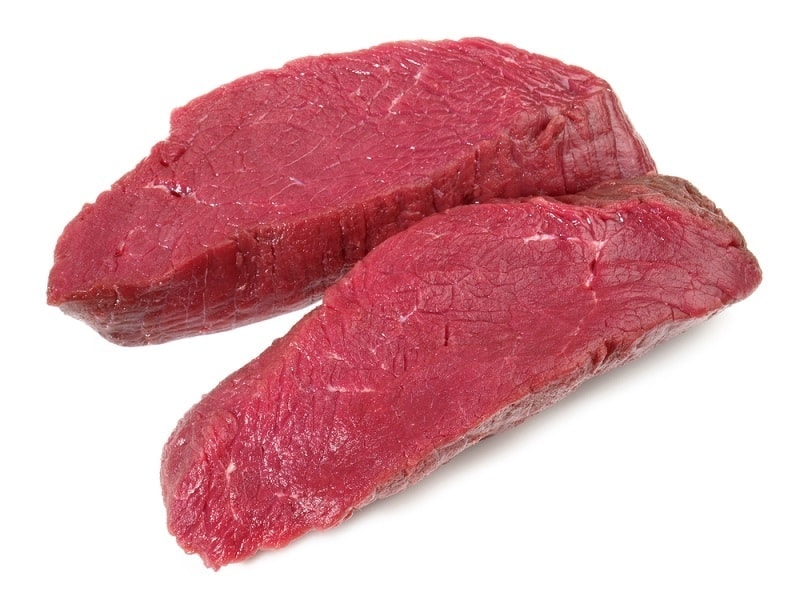
Another meat that’s not commonly found in commercial kibbles, ostrich has roughly as much protein as beef, but it has far less fat and calories. As a result, it’s a great choice for overweight dogs.
The difficulty lies in finding a steady and affordable source of ostrich meat. You’ll likely need to discover a specialty butcher or online retailer to get a steady supply of the stuff.
13. Quail
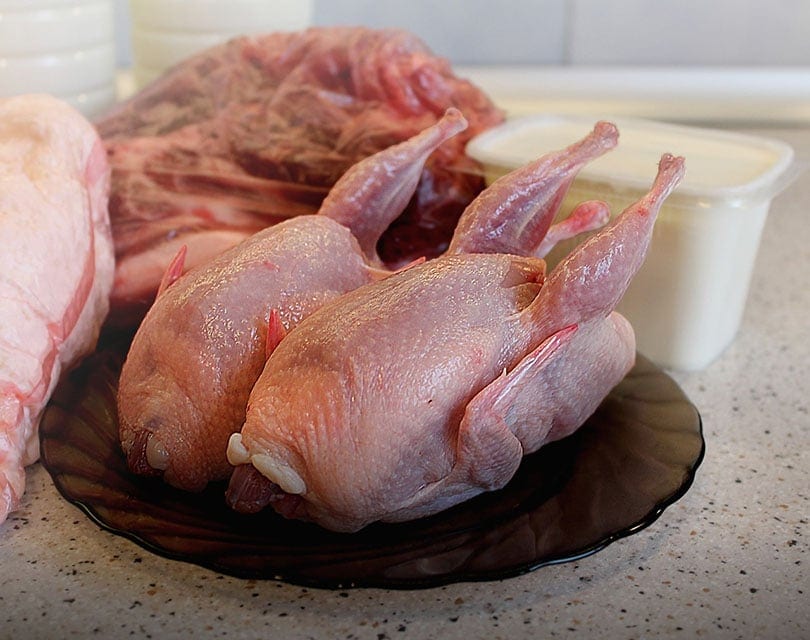
Quail is an extremely gamey bird, and that can make it difficult for some dogs to tolerate (although they do better with it than people do). It’s not often found in kibble, and it can be difficult to track down at butcher shops and grocery stores, but the birds are a popular target for hunters. If you bring some of this meat home, your dog will appreciate it if you share.
The problem with quail is finding enough to feed it to your dog regularly. If you can track down a reliable supplier, though, it’s a wonderful, protein-rich food for pups.
14. Alligator

Alligator is a novel protein alternative that is becoming more common for dogs and humans alike. Alligator is often paired with other meats, especially in specialty foods. Those kibbles are almost always quite expensive, though.
Most dogs will eat alligator if given the chance—which is the problem. You may want to start your dog on something easier to find, rather than having to switch them to a new diet if your supply dries up.
15. Kangaroo
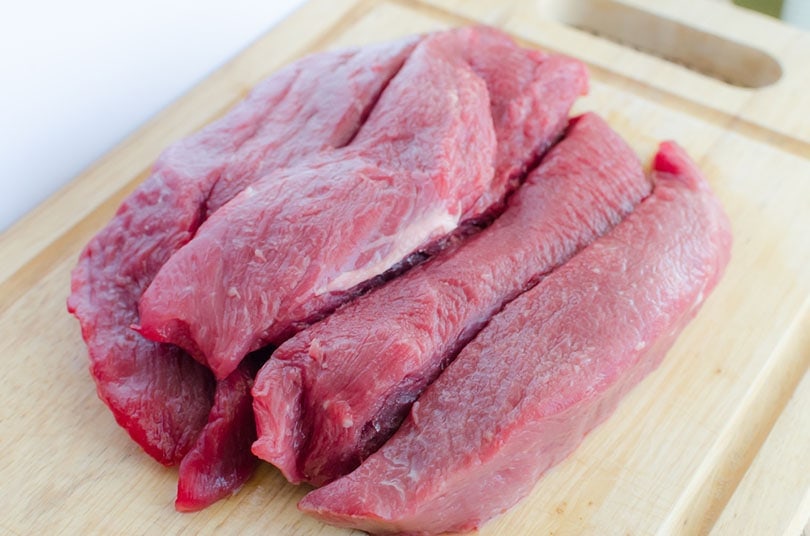
Another meat that’s becoming more ubiquitous in commercial kibbles, kangaroo is lean and has as much protein as beef. It’s also easy for dogs to tolerate, making it a good choice for dogs with food sensitivities.
As you might expect, most kangaroo meat comes from Australia, so expect it to be on the pricey side. It’s also difficult to find in grocery stores or butcher shops.
16. Pheasant
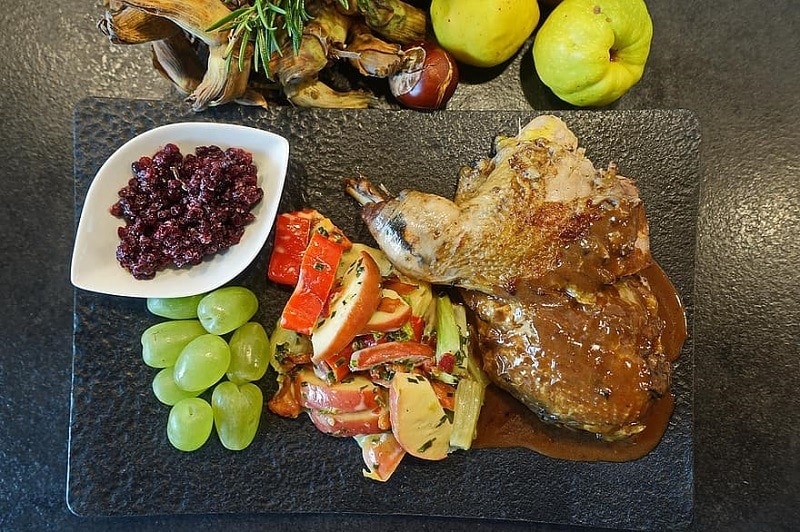
Like quail, pheasant is hard to find commercially, but many hunters may have access to it. If you can find it, it will make a great protein source for your dog. It’s like a turbocharged version of chicken, as it has more protein and less fat than its more common cousin.
If you’re having trouble tracking down pheasant, look for kibbles with “game bird” recipes. These typically have a mix of birds inside, and pheasant is usually one of them.
17. Rabbit

Rabbit has as much protein as chicken, and many dogs love the taste. It’s also easier to find than other “exotic” meats.
In fact, there are quite a few high-end kibbles with rabbit in the recipe, but they sometimes have other meats in them. You can find rabbit meat in nearly every butcher shop, though, and it’s a popular target for hunters.
18. Organ Meats

Many people balk at feeding organ meats to their dog because of the “ick” factor, but they’re full of important amino acids, vitamins, and minerals not found in leaner cuts. Many organ meats come from chicken, though beef hearts, livers, and stomachs are also popular.
Organ meats are such a valuable source of nutrients that many kibbles include them already; they’re just labeled as “by-products.” By-product meals involve taking all the non-lean cuts of meat and mixing them. It’s not much fun to think about, but it can be an important source of nutrition for your pup.
If you’re getting organ meats from your butcher, you should understand up front that many dogs don’t care for the taste. You may have to experiment a bit to find some that your pooch will tolerate.
 Which Type of Meat Is Best for Dogs?
Which Type of Meat Is Best for Dogs?
There isn’t really a definitive answer to the “best” meat for dogs. It depends on factors like your dog’s weight and health, your budget, and your access to specialty foods.
However, don’t convince yourself that exotic and hard-to-find meats are better than old standbys like chicken and beef. Those foods are popular for a reason, and they can be important parts of healthy, balanced diets.
As a matter of fact, we recommend keeping things simple unless you have a good reason to do otherwise. You can save yourself a great deal of money and hassle by sticking with a chicken- or beef-based food, and your dog will likely love them just as much as high-end meat imported from a faraway locale.
You can then use all the money you’ve saved to buy your dog more treats and toys. Everyone’s a winner!
See also:
Featured Image Credit: Phil Stev, Shutterstock


 Which Type of Meat Is Best for Dogs?
Which Type of Meat Is Best for Dogs?